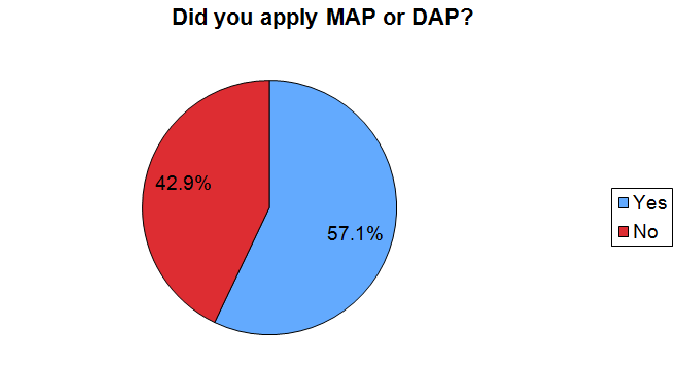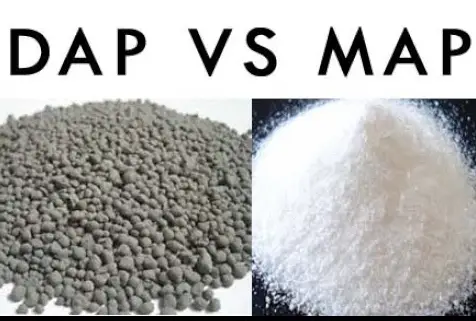Fertilizers play a pivotal role in modern agriculture, providing essential nutrients that enhance plant growth and boost crop yields. Among the various types available, Monoammonium Phosphate (MAP) and Diammonium Phosphate (DAP) fertilizers are particularly notable. Each serves specific agricultural needs and choosing the right one can significantly impact farming outcomes.
MAP and DAP fertilizers differ mainly in their nutrient content and the chemical behavior they exhibit upon application to the soil. MAP, composed of 11% nitrogen and 52% phosphorus pentoxide, is often preferred when nitrogen efficiency is critical. DAP, on the other hand, offers 18% nitrogen and 46% phosphorus pentoxide, making it suitable for kick-starting rapid plant growth in the early stages.
While both MAP and DAP are essential for healthy crop production, they cater to different soil types and cropping conditions. Understanding their chemical properties, nutrient content, and environmental impact helps farmers make informed decisions that align with sustainable agricultural practices and ensure optimal crop health.

Fertilizer Basics
What is Fertilizer?
Fertilizers are substances that are spread or applied to soil to improve its fertility and enhance plant growth. The primary purpose of using fertilizers is to augment the natural nutrient supply in the soil, ensuring that plants have adequate nutrients to grow healthily and produce high yields. Fertilizers can be synthetic or organic, each with unique properties and benefits.
Key Nutrients Explained
The effectiveness of fertilizers largely depends on three critical nutrients:
- Nitrogen (N): Essential for leaf growth and the green color of plants, nitrogen is crucial for photosynthesis.
- Phosphorus (P): Supports the development of roots, flowers, seeds, and fruits.
- Potassium (K): Helps in water absorption, enzyme activation, and overall plant health.
These nutrients, often referred to as N-P-K, form the cornerstone of most fertilizer formulations and are vital for plant nutrition and soil fertility.
MAP Fertilizer
Definition and Composition
Monoammonium Phosphate (MAP) is a widely used fertilizer that delivers two major nutrients: phosphorus and nitrogen. It typically contains 11% nitrogen and 52% phosphorus pentoxide. Its high phosphorus content is ideal for supporting root development and flowering in plants.
Agricultural Benefits
MAP fertilizer offers several benefits for agricultural use:
- Enhanced Root Strength: By providing phosphorus, MAP strengthens the root systems of young plants, crucial for absorbing nutrients and water.
- Reduced Leaching: Due to its relatively stable chemical structure, MAP does not leach easily from the soil, making it more effective and environmentally friendly.
- Versatile Application: It can be applied in granular form or dissolved in water for use as a foliar spray.
DAP Fertilizer
Understanding DAP
Diammonium Phosphate (DAP) is another popular phosphate fertilizer, known for its high nutrient content of 18% nitrogen and 46% phosphorus pentoxide. It is favored for its dual functionality, providing essential nutrients that promote the rapid initial development of plants.
Role in Crop Yield
DAP is particularly effective at boosting crop yield through:
- Rapid Seedling Growth: The high phosphorus content speeds up the germination and development of seedlings.
- Improved Biomass: The nitrogen in DAP aids in the rapid buildup of plant biomass, crucial for fast-growing crops.
Key Differences
Nutrient Content Comparison
While both MAP and DAP provide phosphorus and nitrogen, the ratio and concentration differ:
- MAP: Higher phosphorus content suitable for root development.
- DAP: Higher nitrogen content, which is excellent for early plant growth.
Impact on Soil pH
The impact of these fertilizers on soil pH is significant and must be considered during application:
- MAP: Tends to slightly acidify the soil, which can be beneficial in alkaline soils.
- DAP: Generally raises the soil pH, which can help in acidic soils but might require management to avoid adverse effects.
Usage Guidelines
When to Use MAP
Choosing the right time to apply Monoammonium Phosphate (MAP) can significantly enhance its effectiveness. Here are key scenarios for its optimal use:
- At Planting: Incorporate MAP into the soil during planting to give seedlings an early phosphorus boost.
- For Root Crops: Use it for root vegetables like carrots and potatoes, where strong root development is crucial.
Optimal Use of DAP
Diammonium Phosphate (DAP) is most effective when used under specific conditions:
- Before Sowing: Apply DAP to the soil before planting to ensure nutrients are available when seeds germinate.
- For Fast-Growing Crops: Ideal for crops that need quick growth, such as wheat and corn.
Advantages and Drawbacks
Pros of MAP
The advantages of using MAP include:
- Efficient Nutrient Uptake: With its low mobility in soil, MAP reduces nutrient runoff and enhances uptake.
- Less Alkaline Influence: Unlike DAP, MAP does not significantly increase soil pH, maintaining soil health.
Cons of DAP
The drawbacks of using DAP are notable:
- Potential for Volatility: DAP can volatilize under certain conditions, losing nitrogen to the atmosphere.
- pH Increase: Its application can lead to an undesirable rise in soil pH, affecting nutrient availability.
Environmental Impact
Ecological Considerations
The ecological impact of fertilizers like MAP and DAP is profound. Key considerations include:
- Nutrient Runoff: Both can contribute to nutrient runoff, leading to eutrophication in nearby water bodies.
- Soil Health: Excessive use can degrade soil structure and biodiversity.
Sustainable Practices
Promoting sustainable fertilizer use involves:
- Precision Farming: Using GPS and IoT technology to apply fertilizers more precisely and efficiently.
- Integrated Soil Fertility Management: Combining organic and inorganic inputs to optimize soil health and productivity.
Case Studies
Success Stories
Several case studies highlight the benefits of properly using MAP and DAP:
- Increased Yields in Brazil: Farmers in Brazil used MAP effectively to double soybean yields.
- Enhanced Wheat Production: In India, strategic DAP application increased wheat production by 30%.
Lessons Learned
Important lessons from these experiences include:
- Balanced Application: Overuse of fertilizers can lead to diminishing returns.
- Soil Testing: Regular soil testing can help tailor fertilizer use to actual soil needs.
FAQs
What is MAP Fertilizer?
Monoammonium Phosphate (MAP) fertilizer is a granular form of phosphate fertilizer that provides a balanced supply of phosphorus and nitrogen. It’s highly soluble and particularly effective in improving root development and flowering in plants.
What is DAP Fertilizer?
Diammonium Phosphate (DAP) fertilizer is another widely used phosphate fertilizer, delivering both nitrogen and phosphorus to plants. It is known for rapidly increasing biomass and hastening maturity in crops, making it ideal for use at planting stages.
How do MAP and DAP affect soil pH?
MAP and DAP fertilizers influence soil pH differently due to their chemical compositions. MAP can slightly lower soil pH, making it beneficial for slightly alkaline soils, while DAP tends to increase pH levels, which can be advantageous in acidic soils.
When should I use MAP over DAP?
MAP should be used when plants require higher phosphorus levels without a significant increase in soil pH. It is especially beneficial during the germination and seeding stages of crop growth.
What are the environmental impacts of using DAP?
The use of DAP can lead to increased soil alkalinity and potential runoff issues, which might contribute to water eutrophication. Responsible management and application techniques are essential to mitigate these environmental impacts.
Conclusion
In conclusion, while both MAP and DAP fertilizers are indispensable tools in agriculture, their application must be judiciously managed to align with specific crop needs and environmental considerations. Each fertilizer has its strengths and contexts where it performs best, and the decision to use one over the other should be guided by soil type, crop requirements, and ecological sustainability.
The selection between MAP and DAP can greatly influence agricultural outcomes. Farmers and agricultural professionals must weigh the benefits and limitations of each to optimize crop health, yield, and environmental well-being, thereby ensuring a sustainable agricultural future.

